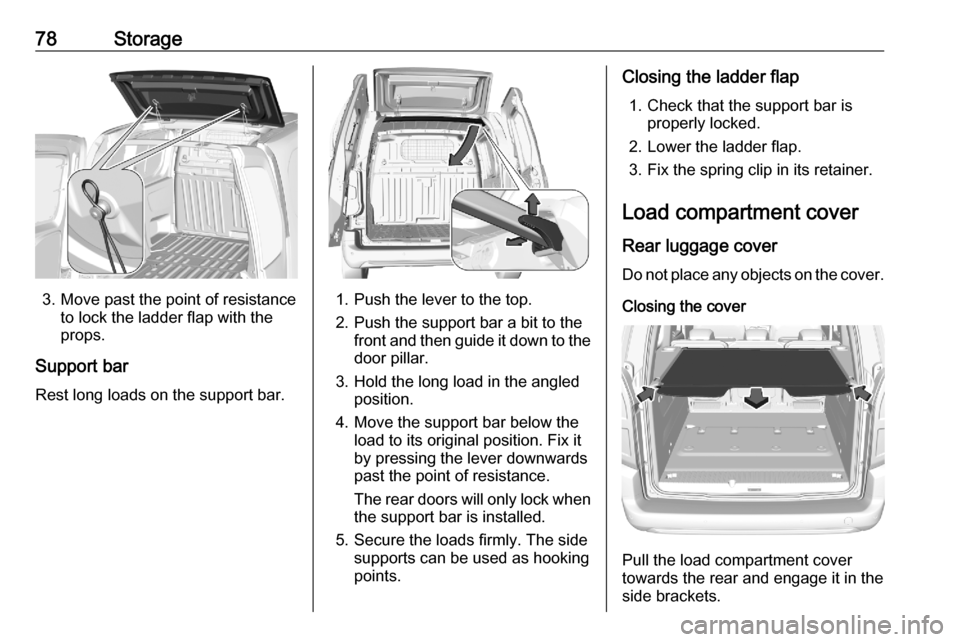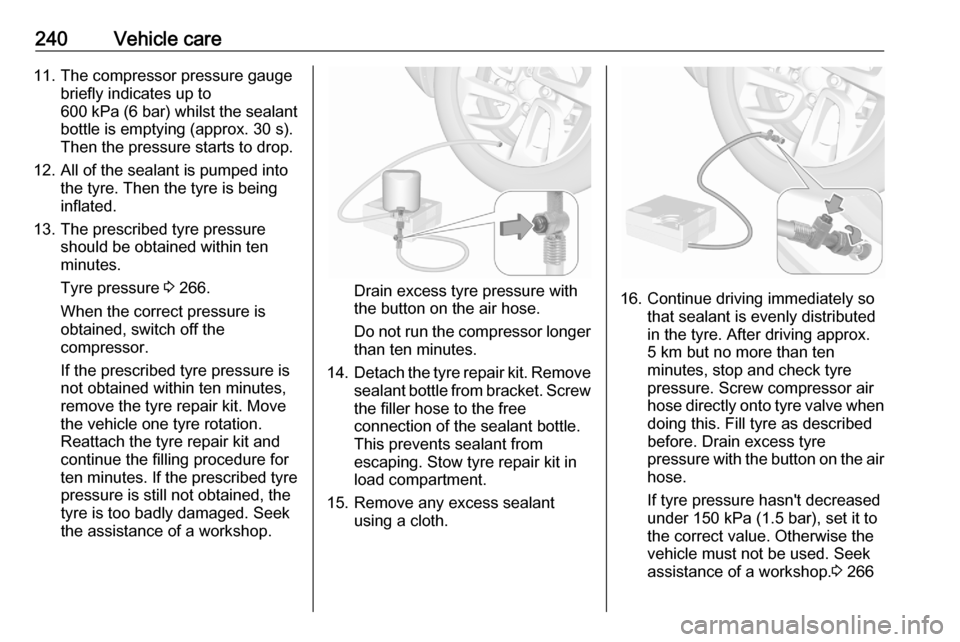tow bar OPEL COMBO E 2020 Manual user
[x] Cancel search | Manufacturer: OPEL, Model Year: 2020, Model line: COMBO E, Model: OPEL COMBO E 2020Pages: 283, PDF Size: 29.4 MB
Page 63 of 283

Seats, restraints61geschĂŒtzt ist, da dies den TOD oder
SCHWERE VERLETZUNGEN DES
KINDES zur Folge haben kann.
FR: NE JAMAIS utiliser un siĂšge
d'enfant orienté vers l'arriÚre sur un
siÚge protégé par un COUSSIN
GONFLABLE ACTIF placé devant lui,
sous peine d'infliger des
BLESSURES GRAVES, voire
MORTELLES Ă l'ENFANT.
ES: NUNCA utilice un sistema de
retenciĂłn infantil orientado hacia
atrĂĄs en un asiento protegido por un
AIRBAG FRONTAL ACTIVO. Peligro de MUERTE o LESIONES GRAVES
para el NIĂO.
RU: ĐĐĐĐ ĐĐ©ĐĐйХЯ
ŃŃŃĐ°ĐœĐ°ĐČлОĐČĐ°ŃŃ ĐŽĐ”ŃŃĐșĐŸĐ”
ŃĐŽĐ”ŃжОĐČĐ°ŃŃДД ŃŃŃŃĐŸĐčŃŃĐČĐŸ лОŃĐŸĐŒ
ĐœĐ°Đ·Đ°ĐŽ ĐœĐ° ŃĐžĐŽĐ”ĐœŃĐ” Đ°ĐČŃĐŸĐŒĐŸĐ±ĐžĐ»Ń,
ĐŸĐ±ĐŸŃŃĐŽĐŸĐČĐ°ĐœĐœĐŸĐŒ ŃŃĐŸĐœŃĐ°Đ»ŃĐœĐŸĐč
ĐżĐŸĐŽŃŃĐșĐŸĐč Đ±Đ”Đ·ĐŸĐżĐ°ŃĐœĐŸŃŃĐž, Đ”ŃлО
ĐĐĐĐŁĐšĐĐ ĐĐ ĐĐąĐĐПЧĐĐĐ! ĐŃĐŸ
ĐŒĐŸĐ¶Đ”Ń ĐżŃĐžĐČĐ”ŃŃĐž Đș ĐĄĐĐРйРОлО
ĐĄĐĐ ĐŹĐĐĐЫРйРĐĐĐĐĐ
Đ ĐĐĐĐĐĐ.NL: Gebruik NOOIT een achterwaarts
gericht kinderzitje op een stoel met
een ACTIEVE AIRBAG ervoor, om
DODELIJK of ERNSTIG LETSEL van het KIND te voorkomen.
DA: Brug ALDRIG en bagudvendt
autostol pÄ et forsÊde med AKTIV
AIRBAG, BARNET kan komme i
LIVSFARE eller komme ALVORLIGT
TIL SKADE.
SV: AnvÀnd ALDRIG en bakÄtvÀnd
barnstol pÄ ett sÀte som skyddas med en framförvarande AKTIV AIRBAG.
DĂDSFALL eller ALLVARLIGA
SKADOR kan drabba BARNET.
FI: ĂLĂ KOSKAAN sijoita taaksepĂ€in
suunnattua lasten turvaistuinta
istuimelle, jonka edessÀ on
AKTIIVINEN TURVATYYNY, LAPSI
VOI KUOLLA tai VAMMAUTUA
VAKAVASTI.
NO: Bakovervendt
barnesikringsutstyr mÄ ALDRI brukes
pÄ et sete med AKTIV
KOLLISJONSPUTE foran, da det kan fĂžre til at BARNET utsettes for
LIVSFARE og fare for ALVORLIGE
SKADER.PT: NUNCA use um sistema de
retenção para crianças voltado para
trĂĄs num banco protegido com um
AIRBAG ACTIVO na frente do
mesmo, poderĂĄ ocorrer a PERDA DE
VIDA ou FERIMENTOS GRAVES na
CRIANĂA.
IT: Non usare mai un sistema di
sicurezza per bambini rivolto
all'indietro su un sedile protetto da AIRBAG ATTIVO di fronte ad esso:
pericolo di MORTE o LESIONI
GRAVI per il BAMBINO!
EL: Î Î΀ΠΌη ÏÏηÏÎčÎŒÎżÏÎżÎčΔίÏΔ ÏαÎčÎŽÎčÎșÏ
ÎșΏΞÎčÏΌα αÏÏÎ±Î»Î”ÎŻÎ±Ï ÎŒÎ” ÏÎżÏÎŹ ÏÏÎżÏ Ïα
ÏÎŻÏÏ ÏΔ ÎșΏΞÎčÏΌα ÏÎżÏ
ÏÏÎżÏÏαÏΔÏΔÏαÎč
αÏÏ ÎŒÎ”ÏÏÏÎčÎșÏ ÎÎÎÎĄÎÎ ÎÎÎĄÎÎŁÎÎÎ, ÎŽÎčÏÏÎč ÏÎż ÏαÎčÎŽÎŻ ÎŒÏÎżÏΔί Μα Ï
ÏÎżÏÏΔί
ÎÎÎÎÎŁÎÎÎ Îź ÎŁÎÎÎÎĄÎ
΀ΥÎ΄ÎÎ΀ÎÎŁÎÎ.
PL: NIE WOLNO montowaÄ fotelika
dzieciÄcego zwrĂłconego tyĆem do
kierunku jazdy na fotelu, przed
ktĂłrym znajduje siÄ WĆÄCZONA
PODUSZKA POWIETRZNA.
Niezastosowanie siÄ do tego
zalecenia moĆŒe byÄ przyczynÄ
ĆMIERCI lub POWAĆ»NYCH
OBRAĆ»EĆ u DZIECKA.
Page 80 of 283

78Storage
3. Move past the point of resistanceto lock the ladder flap with the
props.
Support bar Rest long loads on the support bar.1. Push the lever to the top.
2. Push the support bar a bit to the front and then guide it down to thedoor pillar.
3. Hold the long load in the angled position.
4. Move the support bar below the load to its original position. Fix it
by pressing the lever downwards
past the point of resistance.
The rear doors will only lock when the support bar is installed.
5. Secure the loads firmly. The side supports can be used as hooking
points.
Closing the ladder flap
1. Check that the support bar is properly locked.
2. Lower the ladder flap.
3. Fix the spring clip in its retainer.
Load compartment cover
Rear luggage cover Do not place any objects on the cover.
Closing the cover
Pull the load compartment cover
towards the rear and engage it in the
side brackets.
Page 186 of 283

184Driving and operatingEmergency automatic braking may
slow the vehicle to a complete stop to
try to avoid a potential crash.
â Automatic transmission: If the vehicle comes to a completestop, automatic braking is
maintained for up to two
seconds. Keep the brake pedal
depressed to prevent the vehicle
from starting off again.
â Manual transmission: If the vehicle comes to a complete
stop, the engine may stall.
Operation of the function may be felt
by a slight vibration in the brake
pedal.9 Warning
Emergency automatic braking is
an emergency crash preparation
feature and is not designed to
avoid crashes. Do not rely on the
system to brake the vehicle.
Emergency automatic braking will
not brake outside of its operating speed range and only responds to
detected vehicles and
pedestrians.
System limitations
In some cases, the active emergencybraking system may provide an
automatic braking in situations that
seem to be unnecessary, for instance
in parking garages, due to traffic signs
in a curve or due to vehicles in
another lane. This is normal
operation, the vehicle does not need
service. Firmly apply the accelerator
pedal to override the automatic
braking if the situation and the
surroundings permit.
In the following cases, active
emergency braking performance is
limited:
â driving on winding or hilly roads
â detecting all vehicles, especially vehicles with a trailer, tractors,
muddy vehicles, etc.
â detecting a vehicle when weather
limits visibility, such as in fog,
rain, or snow
â driving during nighttime
â windscreen damaged or stickeredComplete attention is always requiredwhile driving, and you should be
ready to take action and apply the
brakes and / or steer the vehicle to
avoid crashes.
We recommend to deactivate the
system in the vehicle personalisation
in the following cases:
â when towing a trailer or caravan
â when carrying long objects on roof bars or a roof rack
â when the vehicle is being towed with the engine running
â when a spare wheel is fitted that is smaller than the other wheels
â before using an automatic car wash with the engine running
â before placing the vehicle on a rolling road in a workshop
â if the windscreen has been damaged close to the camera
â if the front bumper has been damaged
â if the brake lights are not working
Page 197 of 283

Driving and operating195Operation conditions
The following conditions must be
fulfilled for proper operation:
â all vehicles are moving in the same direction and in adjacent
lanes
â the speed of your vehicle is between 12 and 140 km/h
â passing a vehicle with a speed difference of less than 10 km/h
â another vehicle is passing with a speed difference of less than
25 km/h
â the traffic flow is normal
â driving on a straight or slightly curved road
â the vehicle is not pulling a trailer â the sensors are not covered by mud, ice or snow
â the warning zones in the door mirrors or the detection zones on
front and rear bumper ar not
covered with adhesive labels or
other objectsNo alert will be given in the following
situations:
â in the presence of non-moving objects, e.g. parked vehicles,
barriers, street lamps, road signs
â with vehicles moving in the opposite direction
â driving on a winding road or a sharp corner
â when passing or being passed by
a very long vehicle, e.g. lorry,
coach, which is at the same time
detected at the rear in the blind
spot angle and present in the
driver's forward field of vision
â in very heavy traffic, vehicles detected in front and behind are
confused with a lorry or a
stationary object
â when passing too quickly
Deactivation The system is deactivated in the
vehicle personalisation 3 118. B
extinguishes in the instrument cluster.
Additionally, an acoustic signal
sounds.The state of the system is stored
when switching off the ignition.
The system is automatically
deactivated when towing an
electrically connected trailer.
Due to adverse weather conditions
such as heavy rain, false detections
may occur.
Fault
In the event of a fault, B flashes for a
few moments in the instrument panel,
accompanied by C and a display
message. Have the cause of the fault remedied by a workshop.
Passenger side camera
The passenger side camera monitors the side of the vehicle.
Page 211 of 283

Driving and operating209Trailer hitch
General information
Only use towing equipment that has
been approved for your vehicle.
Entrust retrofitting of towing
equipment to a workshop. It may be
necessary to make changes that
affect the cooling system, heat
shields or other equipment.
The bulb outage detection function for trailer brake light cannot detect a
partial bulb outage e.g. in case of four
bulbs with a power of 5 W each, the
function only detects lamp outage
when only a single 5 W lamp remains
or none remain.
Fitting of towing equipment could
cover the opening of the towing eye.
If this is the case use the coupling ball
bar for towing. Always keep the
coupling ball bar in the vehicle to have it on hand if needed.Driving characteristics and
towing tips
Before attaching a trailer, lubricate
the coupling ball. However, do not do
so if a stabiliser, which acts on the
coupling ball, is being used to reduce
snaking movements.
During trailer towing do not exceed a
speed of 80 km/h. A maximum speed
of 100 km/h is only appropriate if an
oscillation damper is used and the
permissible gross trailer weight does
not exceed the vehicleâs curb weight.
For trailers with low driving stability
and caravan trailers, the use of an
oscillation damper is strongly
recommended.
If the trailer starts snaking, drive more slowly, do not attempt to correct the
steering and brake sharply if
necessary.
When driving downhill, drive in the
same gear as if driving uphill and
drive at a similar speed.
Adjust tyre pressure to the value
specified for full load 3 266.Trailer towing
Trailer loads
The permissible trailer loads are
vehicle and engine-dependent
maximum values which must not be
exceeded. The actual trailer load is
the difference between the actual
gross weight of the trailer and the
actual coupling socket load with the
trailer coupled.
The permissible trailer loads are
specified in the vehicle documents. In general, they are valid for inclines up
to 12%.
The permissible trailer load applies
up to the specified incline and at sea
level. Since engine power decreases
as altitude increases due to the air
becoming thinner, therefore reducing
climbing ability, the permissible gross
train weight also decreases by 10%
for every 1000 metres of altitude. The gross train weight does not have to be reduced when driving on roads with
slight inclines (less than 8%, e.g.
motorways).
Page 212 of 283

210Driving and operatingThe permissible gross train weight
must not be exceeded. This weight is
specified on the identification plate
3 259.
Vertical coupling load The vertical coupling load is the load
exerted by the trailer on the coupling
ball. It can be varied by changing the
weight distribution when loading the
trailer.
The maximum permissible vertical
coupling load is specified on the
towing equipment identification plate
and in the vehicle documents.
Always aim for the maximum vertical
coupling load, especially in the case
of heavy trailers. The vertical coupling
load should never fall below 25 kg.
Rear axle load
When the trailer is coupled and the
towing vehicle fully loaded, the
permissible rear axle load (see
identification plate or vehicle
documents) may be exceeded by
60 kg , the gross vehicle weight rating
must not be exceeded. If thepermissible rear axle load is
exceeded, a maximum speed of
100 km/h applies.
Towing equipment Depending on version the vehicle canbe fitted with a detachable or a fixed
coupling ball bar.
Type ACaution
When operating without a trailer,
remove the coupling ball bar.
Fitting the coupling ball bar
1. Place the key in the lock and
unlock the coupling ball bar. Move
the lever to the rear position.
2. Clean the contact points with a soft clean cloth.
Page 213 of 283

Driving and operating2113. Insert the coupling ball bar in theopening and push firmly up to the
stop.
Secure the coupling ball bar
correctly by moving the lever to
the locked position, shown in the
picture.
4. Lock the coupling ball bar by turning the key. Remove the key
and close the protective flap.
5. Attach the trailer.
6. Fold the socket forward.
7. Connect the trailer plug to the socket.
8. Attach the breakaway stoppingcable to the eye on the carrier.
9 Warning
Towing a trailer is permitted only
when a coupling ball bar is fitted correctly. If the coupling ball bardoes not engage correctly, seekthe assistance of a workshop.
Dismounting coupling ball bar
1. Disconnect the trailer plug.
2. Unfasten the breakaway stopping
cable.
3. Remove the trailer.
4. Open the protective flap and unlock the coupling ball bar with
the key.
5. Move the lever of the coupling ball
bar to the rear position. Remove
the coupling ball bar by pulling it.
Page 214 of 283

212Driving and operating
6.Move the lever of the coupling ball
bar to the front position.
Type B
1. Connect the trailer plug to the socket and fasten the breakaway
stopping cable to the eye on the
carrier.
2. Attach the trailer.
Type C
1. Remove the safety splint.
2. Pull the lever and open the towing
ring.
3. Attach the trailer, close the towing
ring and fix the splint.
Page 242 of 283

240Vehicle care11. The compressor pressure gaugebriefly indicates up to600 kPa (6 bar) whilst the sealant
bottle is emptying (approx. 30 s).
Then the pressure starts to drop.
12. All of the sealant is pumped into the tyre. Then the tyre is being
inflated.
13. The prescribed tyre pressure should be obtained within ten
minutes.
Tyre pressure 3 266.
When the correct pressure is
obtained, switch off the
compressor.
If the prescribed tyre pressure is
not obtained within ten minutes,
remove the tyre repair kit. Move
the vehicle one tyre rotation.
Reattach the tyre repair kit and
continue the filling procedure for ten minutes. If the prescribed tyre pressure is still not obtained, the
tyre is too badly damaged. Seek
the assistance of a workshop.
Drain excess tyre pressure with
the button on the air hose.
Do not run the compressor longer
than ten minutes.
14. Detach the tyre repair kit. Remove
sealant bottle from bracket. Screw
the filler hose to the free
connection of the sealant bottle.
This prevents sealant from
escaping. Stow tyre repair kit in
load compartment.
15. Remove any excess sealant using a cloth.16. Continue driving immediately so that sealant is evenly distributed
in the tyre. After driving approx.
5 km but no more than ten
minutes, stop and check tyre
pressure. Screw compressor air
hose directly onto tyre valve when doing this. Fill tyre as described
before. Drain excess tyre
pressure with the button on the air
hose.
If tyre pressure hasn't decreased under 150 kPa (1.5 bar), set it to
the correct value. Otherwise the
vehicle must not be used. Seek
assistance of a workshop. 3 266
Page 243 of 283

Vehicle care241Repeat the checking procedure
once more after driving further
10 km but no more than ten
minutes to check that there is no
more loss of pressure.
If the tyre pressure has fallen
below 150 kPa (1.5 bar), the
vehicle must not be used. Seek
the assistance of a workshop.
17. Stow away tyre repair kit in load compartment.
Note
The driving characteristics of the
repaired tyre are severely affected, therefore have this tyre replaced.
If unusual noise is heard or the
compressor becomes hot, turn
compressor off for at least 30 min.
The built-in safety valve opens at a
pressure of 700 kPa (7 bar).
Note the expiry date of the kit. After
this date its sealing capability is no
longer guaranteed. Pay attention to
storage information on sealant
bottle.Replace the used sealant bottle. Dispose of the bottle as prescribed
by applicable laws.
The compressor and sealant can be
used from approx. -30 °C.
Wheel changing Make the following preparations and
observe the following information:
â Park the vehicle on a level, firm and non-skid surface. The front
wheels must be in the straight- ahead position.
â If necessary, place a chock under
the wheel diagonally opposite the wheel to be changed.
â Apply the parking brake and engage first gear, reverse gear or
P .
â If the ground on which the vehicle
is standing is soft, a solid board
(max. 1 cm thick) should be
placed under the jack.
â Take heavy objects out of the vehicle before jacking up.
â No people or animals may be in the vehicle when it is jacked-up.â Never crawl under a jacked-up vehicle.
â Do not start the vehicle when it is
raised on the jack.
â Before screwing in the wheel bolts, clean them.9Warning
Do not grease wheel bolts.
Tightening torques
Caution
If the vehicle is equipped with alloy
wheels, tighten the wheel bolts
manually at least for the first five
turns.
There are two different types of
wheels with two different bolts and tightening torques.